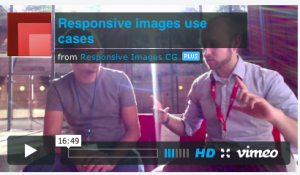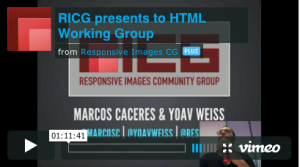RICG at TPAC 2012
During TPAC 2012, Yoav Weiss and I (Marcos Cáceres) had the opportunity to present the work of RICG to the W3C membership. We gave 2 presentations during TPAC:
- Panel discussion, on Wednesday during the Tech Plenary
- A one hour presentation and QA session to the HTMLWG about responsive images.
Panel Discussion
The panel discussion was organised by Odin Hørthe Omdal of Opera Software, Yoav, and I, and we were fortunate to have participation from Ted O’Conner (editor of the srcset specification) from Apple, and from Travis Leithead from Microsoft. During the session, Yoav and I presented the use cases and we did a demo using the prototype implementation. Minutes are available. After we presented, we handed the mic over to Ted and to Odin, who outlined some of the issues with relying on CSS Media Queries, as currently does, in the markup.
Ted argued that some of the use cases could be met by using CSS to crop certain images into size. Ted also pointed out that many of responsive images use cases can be addressed with other platform features: CSS filters and shaders, svg. Thus, it’s not necessary to cover every single case with a one-fits-all solution because other parts of the platform (e.g., JS libraries) can be used to achieve the 20% cases that require something more specific. As recorded in the minutes, “we might do authors a disservice by designing something that they use instead of other, more suitable features”.
Then Odin raised some good points about having a truly declarative model for responsive images: that is, one where a developer only hints at the browser what they require, and then the browser handles fetching the appropriate resource if a declared condition is met and if it’s appropriate. He argued that this is embodied in the srcset proposal. This is in contrast with the current approach proposed by the picture element, which more forcefully tells the browser what to do (through media queries). This approach opens up a number of interesting use cases (e.g., allowing the user to tell the browser to only serve them the low quality or high quality images – akin to what Opera Mini does). This approach is not without its problems, as it does not handle “art direction” well, but it’s still interesting enough that it should be added to the use cases document.
Other things that come up during the panel were related to looking at how video solves the “adaptive” problem. To me personally, this seemed a bit too experimental (i.e., might require new formats or might require doing some nasty hacks with , which would probably be no better than what we are doing today with responsive image polyfills)… but who knows! I’m no video expert, so there may be something there worth looking into (NB: just this week, Ian Devlin posted an article/test showing this working!).
As I personally found Odin’s ideas very interesting (as they pin-point to the devision between designers and browser vendors), so I asked him is he we could make a short video so we could discuss his ideas further and also give the community an opportunity to think about them:
Responsive images use cases from Responsive Images CG on Vimeo.
HTMLWG presentation
On Thursday, 1st of November, the RICG was invited to present our work to the HTML WG. The presentation went very well, with a good set of questions being asked after we finished presenting. Unfortunately, the minutes from the HTMLWG meeting have not yet been published.
RICG presents to HTML Working Group from Responsive Images CG on Vimeo.





